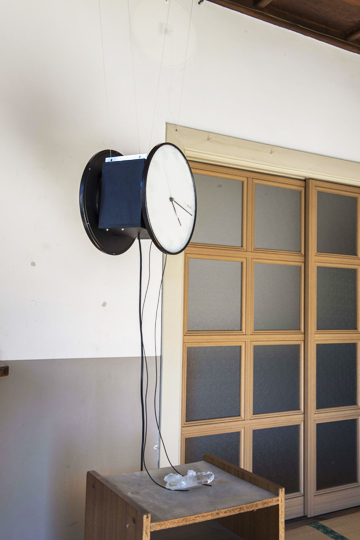TEMPUS ≈ Quartz
2014
W400 x D400 x H1500 (mm)
Quartz, Analog clock, Steel, Acrylic, Wood, Signal generator
If you focus on your own life, you live and depend on the axis of time, made available through timekeeping devices, such as computers and clocks. Amongst their interwoven precision parts, it is the ‘Quartz’ crystal, that provides the steady signal, which almost all electric devices use to control time correctly. The history of the quartz clock which we see anywhere in our life begins in the 1960’s where first units were sold to the public.
The quartz has a special property called the piezoelectric effect. A processed quartz crystal resonates with 32,768Hz per second. This steady quartz frequency is utilized inside the clock as the timekeeping baseline. Natural quartz, before being processed, does resonate on a different frequency. If these natural quartz crystals would be used in a clock for timekeeping, the clock would produce its own unique time. This individual form of timekeeping can be compared with the different standards and paces in our individual lives.
今日では多くの電子機器に「クォーツ」と呼ばれる小さな精密部品が使用されている。クォーツとは水晶のことであり、これが使われている製品のうちで古くから知られるものは「時計」である。水晶には圧電効果と呼ばれる性質があり、特に時計では毎秒32,768Hz という特定の周波数(振動数)で共振する水晶を使用する事で時針の進む速度を一定に保っている。この周波数は、水晶の形、大きさ、透明度などで変化するため、個体差を極力排除したい大量生産品では人工的に合成された不純物の少ない水晶を、確実に目的の周波数で振動させる為の特別な規格に合わせて精密に加工したものが用いられている。しかし、天然の結晶には全く同じ形状、純度ものが一つとして存在していない。つまり、それぞれの個体で異なった固有周波数を持っているという事である。この作品では、通常使用されている規格加工品である「クォーツ」を天然水晶に置き換える事で、各々の水晶の持つ固有周波数で時計を動かしている。それぞれの時計は水晶の結晶自体が持つ固有の時間軸を示しているとも言える。
表裏2台1組の時計。表側は天然水晶が示す水晶固有の時間軸であるのに対し、裏側は我々の住む世界の標準時間を示している。


